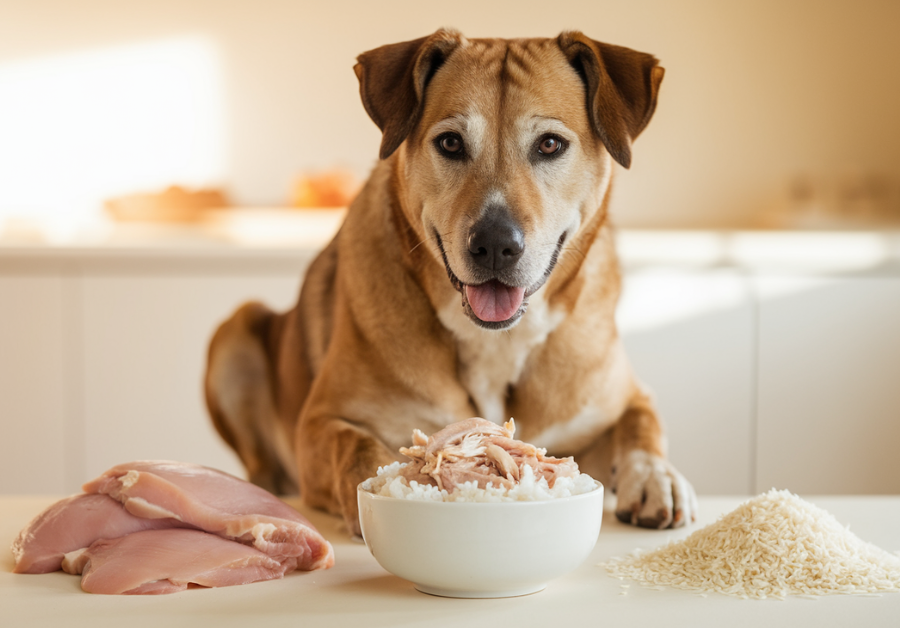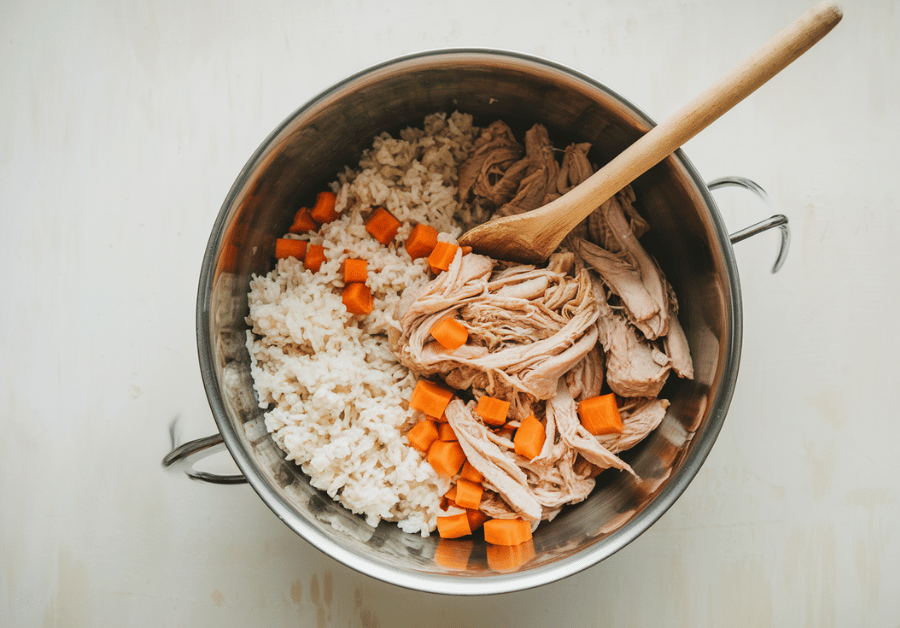Why Choose Our Chicken and Rice Recipe for Dogs for Sensitive Digestion
Dogs can’t exactly tell us when their bellies hurt, but you know the signs—refusal to eat, loose stools, that uncomfortable pacing around the house. If this sounds familiar, a gentle, homemade meal can do wonders to help reset your pup’s digestion.
One tried-and-true option is a simple chicken and rice dish. It’s easy to prepare, packed with basic nutrients, and gentle enough not to aggravate those sensitive tummies. Before diving into the recipe, let’s explore why this classic combination works so well and how to choose the right ingredients to ensure your dog feels better fast.
Why Chicken and Rice Are Ideal for Dogs with Sensitive Digestion

When your dog’s stomach is off-kilter, bland really can be better. That’s where chicken and rice step into the spotlight. Both ingredients are mild, soothing, and widely considered “safe bets” in canine nutrition.
Skinless, boiled chicken is a lean source of protein that’s unlikely to upset your dog’s gut, while plain white rice provides easily digestible carbohydrates. Together, these two staples help settle the stomach, often encouraging a dog to eat again when more complex meals seem off-putting.
But there’s more to it than just their easy-to-digest nature. Chicken and rice contribute essential nutrients that support recovery. High-quality chicken delivers amino acids that help maintain muscle tone and overall energy levels, even when your pet isn’t feeling 100%. White rice—gentler than its brown counterpart—offers quick, digestible energy and a bit of soluble fiber. This fiber can help normalize stool consistency, making chicken and rice a go-to meal for dogs coming off bouts of diarrhea or vomiting.
Selecting the Right Ingredients to Calm Your Dog’s Stomach
When preparing a chicken and rice meal for a dog with a sensitive stomach, choosing the right ingredients is crucial. Here’s what to look for:
- Chicken: Select skinless, boneless breasts or thighs to avoid extra fat, which can irritate a sensitive stomach. Ensure the chicken is fresh and not seasoned.
- Rice: Choose plain white rice, like long-grain or jasmine, which is easy on the stomach. Avoid any rice that contains added flavors or spices.
- Carrots: Finely chopped and well-cooked carrots offer a gentle source of vitamins without being too harsh on the digestive system.
- Canned Pumpkin (optional): A spoonful of plain canned pumpkin can add fiber, aiding digestion and stool consistency.
- Plain Yogurt (optional): A small amount of plain yogurt can introduce beneficial probiotics to support gut health.
These carefully chosen ingredients ensure the meal is not only palatable and soothing but also nutritious, supporting your dog’s recovery without overwhelming their digestive system.
Step-by-Step Preparation for a Digestive-Friendly Meal
1. Chicken Preparation

Begin by boiling the chicken. This cooking method is ideal as it avoids the use of oils or fats that can aggravate a sensitive stomach. Place the chicken in a pot of cold water, ensuring the meat is fully submerged.
Bring the water to a gentle boil, then reduce the heat and let it simmer. Depending on the size of the cuts, this usually takes about 12 to 15 minutes. The goal is to cook the chicken thoroughly while keeping it tender and easy to digest. Once done, let the chicken cool, and then shred it into small, manageable pieces for your dog.
2. Rice and Carrots Preparation
While the chicken cooks, start on the rice. Rinse the white rice under cold water to remove any excess starch, which can help make the final dish even more digestible.
Cook the rice according to package instructions, but aim for a slightly overcooked texture, which is easier on the stomach. For the carrots, peel and finely chop them, then steam until they are very soft. Overcooking the carrots slightly ensures they are easy for your dog to digest and minimizes the risk of any gastrointestinal irritation.
3. Mixing the Ingredients

Once both the chicken and rice (and possibly carrots) are cooked, it’s time to combine them. In a large bowl, mix the chicken, rice, and carrots together. Ensure there’s a good balance—too much chicken can be protein-heavy for a sensitive stomach, and too much rice might not provide enough nutritional diversity.
If you’ve opted to include pumpkin or yogurt, now is the time to gently fold these into the mixture. The final mixture should be homogenous, moist, and easily spoonable into your dog’s bowl.
Serving Tips and Portion Control for Sensitive Stomachs
Serving Recommendations
When serving the chicken and rice meal, make sure it’s at room temperature to avoid shocking your dog’s digestive system. Portion sizes should be appropriate for your dog’s size and dietary needs. A good starting point is about a cup of food per 20 pounds of body weight, spread across multiple meals throughout the day to ease digestion.
Storage Solutions
If there are leftovers, they can be stored in the refrigerator for up to three days. Ensure the food is cooled down before transferring it to an airtight container; this will help prevent bacterial growth. For longer storage, you can freeze portions in freezer-safe bags or containers. Frozen chicken and rice will last for up to two months. Always thaw frozen meals in the refrigerator before serving.
When to Serve This Chicken and Rice Meal to Your Dog
This homemade chicken and rice meal is particularly beneficial during times of mild stomach distress, such as after a bout of diarrhea or vomiting. It’s also an excellent option for easing your dog back into regular eating after fasting or when switching from a different diet under veterinary guidance. Incorporate this meal into your dog’s diet during recovery phases to provide a smooth transition with easily digestible nutrients.
However, it’s not intended as a long-term diet solution. Chicken and rice are great for short-term relief, but they don’t provide all the nutrients required for comprehensive canine health. Use this meal temporarily until your dog’s digestive system stabilizes, typically for a few days, before reintroducing a more balanced, complete diet.
Recognizing When to Seek Veterinary Help
While chicken and rice can help with mild digestive issues, they are not a cure-all. It’s crucial to monitor your dog’s response to this diet change and watch for signs that may indicate a more serious condition.
If your dog continues to exhibit symptoms like excessive vomiting, diarrhea persists for more than 48 hours, there is blood in their stool, or they show signs of lethargy, dehydration, or discomfort, it’s important to contact your veterinarian immediately. These symptoms could indicate underlying issues that require professional treatment beyond dietary management.
Supporting Long-Term Digestive Health in Dogs
Maintaining your dog’s digestive health involves more than just responding to issues as they arise. Proactively supporting their gut health can prevent many common digestive problems. Consider incorporating a variety of fiber sources, probiotics, and nutrient-rich foods into your dog’s diet under the guidance of a veterinarian. Regular veterinary check-ups will ensure that your dog’s nutritional needs are met and can help catch any emerging health issues early.
Closing Thoughts on the Chicken and Rice Recipe for Dogs
This soothing chicken and rice recipe offers a gentle solution for dogs with sensitive stomachs, providing a bridge back to health during digestive upsets. Remember, while it’s a helpful tool in your pet care arsenal, it’s important to maintain a balanced diet and seek professional advice for persistent issues. Your commitment to understanding and caring for your dog’s dietary needs plays a crucial role in their overall health and happiness.
Thank you for taking the time to ensure your furry friend’s well-being. At Sweet Perfections, we provide recipes and care tips for your pets, helping you make thoughtful, informed choices for their diet that will keep them healthy and content.
Meet Sean, a fintech whiz with a penchant for pet purrs and blockchain buzz. After a decade of fintech feats, Sean’s tech talents leaped from ledger lines to litter lines, driven by a passion for pets and a vision for a more connected pet care community. With three critter companions as co-pilots, Sean launched this blog to share a treasury of pet-friendly tech tips and tales.



